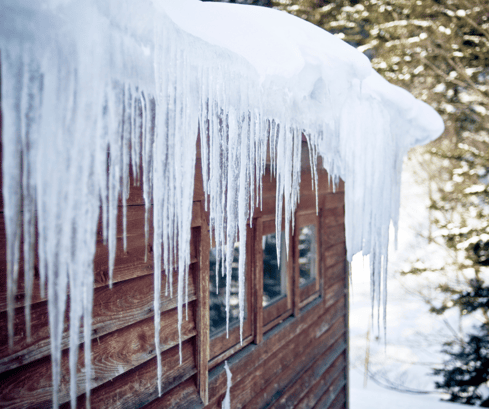This winter has been long… and if Punxsutawney Phil is to be believed, we still have a long way to go. Whether you rejoice in the snow for skiing or are patiently (or impatiently like I am) awaiting the spring, there is a cozy quality that your safe and warm home brings at the end of the day. The last thing any of us want at the end of the day is icy water dripping down into your toasty oasis, but this is a very real possibility if you ignore the ice dam that may be growing on your roof….
Ice dams are formed when the snow on your roof melts and runs to the edge of your roof only to refreeze in giant chunks. They can weigh hundreds of pounds and compromise the integrity of your roof, and push melting water underneath the shingles which then flows down into your living space. Giant overhanging icicles can also break off, suddenly impaling anything or anyone below. 
So, what can you do to protect your home from these frozen menaces?
The best thing you can do is prevent the dams from forming in the first place. Large ice dams are formed partially from natural melting during warm days, but mostly from indoor heat loss through air leakage into the attic or vaulted ceiling. Warm air from your home heats up your roof and melts the snow, resulting in ice dams. This air leakage is also costing you money by allowing the precious heat you pay for to escape and heat your roof instead of your home. You can fix this issue through targeted air sealing and increasing insulation levels in your attic or ceiling., After getting a home energy assessment these projects can be rebated through the Energy Smart Colorado program at Walking Mountains Science Center!
Many people choose to put heat tape on their roofs, but this is a band aid more than a solution. The heat tape may help to melt ice dams, but they use a huge amount of energy, making your utility bills even higher. Heat tape also can also increase your risk of electrical fires if it wears out or if not properly installed. If you already have heat tape installed, you should install a timer so that the heat tape runs in the daytime when it has help from the sun.. Running heat tape at night wastes lots of energy and can actually make ice dams worse. Installing a timer is one way you can improve your home’s efficiency, and rebates are also available for these installs. This can cut the energy consumption and cost of running your heat tape in half!
Don’t get burned by ice! Take care of your home, the earth, your health, and save money by preventing ice dam damage with weatherization and efficiency improvements. For more information reach out to a Walking Mountains Science Center Energy Coach!
Elizabeth Baer is the Sustainability Fellow at Walking Mountains Science Center






